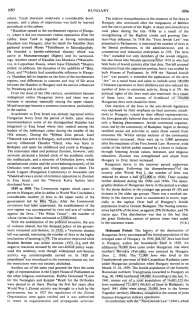<1919 to 1939.
[Jewish Communist
government of Béla Kun in 1919 - fall and "White Terror"]
The Communist regime which came to power in Hungary after
its defeat in World War I included a considerable number of
Jews in the upper ranks of the government led by Béla *Kun.
After the Communist revolution had been suppressed, the
establishment of the new regime was accompanied by riots and
acts of violence against the Jews - "The White Terror" - the
number of whose victims has been estimated at 3,000 dead.
[Anti-Semitic Hungarian
government 1920-1928 - representation law for Jews in
Parliament since 1928]
With the stabilization of the political situation, the acts
of violence abated, but the declared policy of the
government remained anti-Semitic. In 1920, a *
numerus
clausus bill was passed, restricting the number of
Jews in the higher institutions of learning to 5%. The
situation improved while Stephen Bethlen was prime minister
(1921-31), and the negative reactions aroused by the
anti-Jewish policy weakened this tendency, even though
widespread anti-Semitic activity was uninterruptedly carried
on. In 1928 an amendment [[addition]] was introduced to the
numerus clausus act, but the restrictions were not entirely
abolished. Another act of the same year granted the Jews the
same right of representation in the Upper House of
Parliament as the other religious communities. Rabbis
Immanuel *Loew for the Neologists and Koppel *Reich for the
Orthodox were elected to sit there.
[[The events of the collapse of the stock exchange of 1929
and the great economic crisis and unemployment are not
mentiones in the article]].
[Racist Zionism stopped
1920-1927 - and reactivated since 1928]
During the first few years after World War I, Zionist
activity was brought to a halt by the government, but in
1927 the regulations of the Zionist Organization were again
ratified and it was authorized to renew its organizational
and propaganda activities. (col. 1095)
The relative tranquilization in the situation of the Jews in
Hungary also continued after the resignation of Bethlen and
the rise to power of the Right.

Encyclopaedia Judaica (1971): Hungary, vol. 8, col. 1107.
Jewish boy from the Munkacs region,
c. 1930-35. From "The Vanished World", New York, 1949.
Photo Vishniak.
A sharp anti-Jewish turn took place during the late 1930s as
a result of the strengthening of the Rightist circles and
growing German-Nazi influence. In 1938 the "First Jewish
Law" was presented to Parliament; it restricted the number
of Jews in the liberal professions, in the administration,
and in commercial and industrial enterprises to 20%. The
term "Jew" included not only members of the Jewish religion,
but also those who became apostates [[converted]] after 1919
or who had been born of Jewish parents after that date. The
bill aroused objections from the opposition parties, but it
was ratified by both Houses of Parliament.
In 1939 the "Second Jewish Law" was passed;it extended the
application of the term "Jew" on a racial basis and came to
include some 100,000 Christians (apostates or their
children) and also reduced the number of Jews in economic
activity, fixing it at 5%; the political rights of the Jews
were also restricted. As a result of these laws, the sources
of livelihood of 250,000 Hungarian Jews were closed for
them.
One reaction of the Jews to the anti-Jewish legislation was
expressed by their emphasis on their patriotic attachment to
Hungary, voiced by their official representatives; the Jews
generally believed that the anti-Jewish current was only a
fleeting phenomenon. Jewish communal organizations, led by
the community of Budapest, began to develop ramified social
aid activities to assist those ousted from economic life.
Within certain sections of the community conversions
increased; there were up to 5,000 apostates after the
enactment of the First Jewish Law. However, wide circles of
the Jewish public reacted by a return to Judaism, through
fostering Jewish values, literature, and religious
education. [[Racist]] Zionism was strengthened and
aliyah from Hungary to
Erez Israel (Ereẓ Israel) [[Land of Israel]] increased.
[[The number of the Jews emigrating is "unfortunately"
missing. The emigration movement also had other destinations
than Palestine which is not indicated]].
[Numbers - emigration of
the young generation 1919-1939]
Hungarian Jewry in the interwar period underwent great
changes. Following the dismemberment of the country after
World War I, the number of Jews was reduced by about a half
(473,000 in 1920). Their number further declined during the
1920s and 1930s. The demographic decline of Hungarian Jewry
in this period is evident by the sharp decline in the
younger age groups (0-20) and increase in the older age
groups.
There was a marked tendency in the interwar years to
concentrate in towns, especially in the capital. Over half
of Hungary's Jewish population lived in Greater Budapest.
The Neolog communities had 65% of the Jews, as against 29%
Orthodox, and 5% status quo. This distribution was due to
the fact that the great Orthodox centers of prewar times
were ceded [[given]] to the successor states.> (col.
1096)






